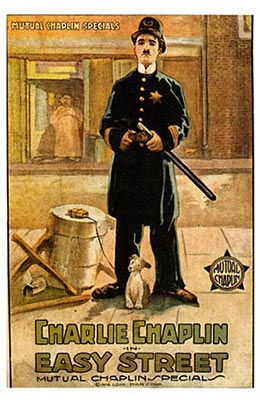
LH found it difficult to view this screen legend without seeing the personality behind the make-up:
‘I never really liked Charlie. I liked the tramp well enough, but even from the first Chaplin film I saw – which was Easy Street, on 8mm in a tent for a penny at a garden fete – I suspected that the amiable character was assumed, and that under the make-up was quite another person, someone autocratic and boastful and rather mean, sentimental and preachy without the wisdom to temper his judgements, brilliantly talented in a wholly natural way, proud of his success but resentful of his low beginnings.’

This English music hall entertainer came to America in 1913 with Fred Karno’s theatrical troupe. His drunk act was spotted by Mack Sennett who invited him to his Keystone studios in Hollywood, where Chaplin would make 35 films, mostly two-reelers (20 minute shorts), before moving to the Essanay Company to make another 16.
‘It is to the early two-reelers that one must return for the essence of Chaplin’s genius, for when he made them he could remember what it was like to be poor, and the mass audience knew it and could identify with him. Once they both grew affluent, they regarded each other with mutual suspicion and apathy.’
In 1917 Chaplin signed a deal with the Mutual Film Corporation giving him unprecedented control over his productions. Over the next eighteen months he would make twelve shorts which would come to be regarded as some of the finest and most influential comedy on film. Among them were Easy Street and The Cure.
‘[Easy Street] is a marvellous short, full of acute observation and blinding fun; the social message is clear enough without Chaplin’s having to break it over our heads as he later did in such misguided moments as the speech at the end of The Great Dictator.’
Halliwell also said of it, in the Filmgoer’s Companion,:
‘Perhaps Chaplin’s most notable two-reeler, a deft combination of farce and social documentary, with jokes about the Salvation Army, overcrowded slums and drug addiction. Still poignant and funny.
And he called The Cure:’
‘…a comic ballet about a spa at which alcohol gets into the water... Chaplin has a way with a revolving door which seems almost like perpetual motion.’
Halliwell |
| Easy Street/The Cure |